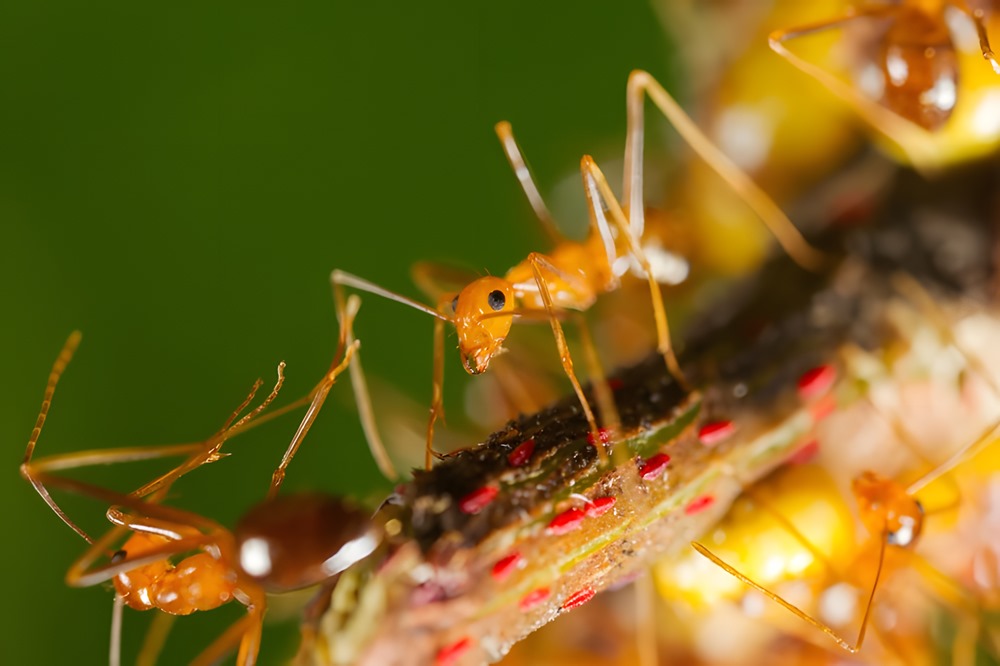
Icrazy yellow ants (Anoplolepis gracilipes) derive their name from the general movements they perform after being alarmed. But there’s another reason to call these invader ants crazy: The males of this species are a mixture of two warring cell lines, researchers report in a new study.
Banner photo: Crazy yellow ants (Anoplolepis gracilipes). (Steven Belcher/Nature Picture Library)
Most male yellow crazy ants carry two distinct sets of DNA, resulting from sperm and egg cells that do not mix their genetic material after fertilization. So the males ChimeraThat is, individuals whose body parts carry one set of genes and other parts carry another set. Male offspring become workers or queens, depending on the DNA of the sperm that fuses with the egg, while male offspring become themselves.
The findings, which solve a 15-year-old mystery about the insect’s genes, reveal a pattern of reproduction hitherto “unknown to science,” according to Hugo Daras of the Johannes Gutenberg University in Mainz, Germany, who adds:
There have been many strange hypotheses to explain what was going on in these ants, but none were as strange as the one we discovered.
Ants usually reproduce by sexual reproduction, with the male’s sperm fertilizing the female’s egg, or by “clonal reproduction”, i.e. the queen produces offspring without genes added from the second parent. Generally, males come from unfertilized eggs and females from fertilized eggs. In most cases, the queens are genetically similar to the workers of the same colony, but they turn into queens because they receive special care and nutrition.
Crazy yellow ants transport a dead cockroach to their nest in Pohnpei, Federated States of Micronesia. (Bradley Rentz / Wikimedia)
In 2007, scientists studied the genome of yellow crazy ants and discovered, to their surprise, that the males had mixed genetic heritage, as if they had two parents. Six years later, another team discovers that all the queens in the colony are descended from the same genetic line and that their worker sisters are descended from a very distinct second line.
Puzzled by this mystery, Daras and his colleagues sequenced the DNA of 53 yellow-crazy ant queens and 91 workers collected from 14 regions of Southeast Asia. Queens were bred, but the workers showed much more genetic diversity. In other words, it appears that the queens were born from parents of the same lineage, while the female workers were born from parents of different lines, even though the males who fathered them all came from the same colony.
Assuming that the colonies consist of two lines of males, the researchers then took 574 males from the same colonies as the queens and workers and sequenced the DNA from their legs. They found that some of the males seemed to share genetic ancestry with the queens, while others seemed more closely related to the workers.
Crazy yellow ants attacking a caterpillar. Follow Favorite
Daras explains that it might have made sense for males to be hatched from fertilized eggs, because that would mean they had two copies of each chromosome, one from each parent. But his team’s analysis revealed that, like most male ants, bees and wasps, they only have one copy of each chromosome, and so appear to have resulted from unfertilized eggs.
Confused, the team tested the DNA of individual cells from 20 of these males. They discovered that within the same insect, roughly half of the cells had genes from one lineage and the other half had genes from another. Looking specifically at the sperm, the team found that one line, which gave birth to the workers, was more abundant than the other.
Further analysis revealed that both lines of these males came from two parents, meaning that the males did indeed descend from fertilized eggs, but unlike the females, the egg nucleus did not fuse with the sperm nucleus. So males ended up with two different sets of chromosomes, carried to different parts of the body.
In retrospect, the researchers realized that the vast majority of male yellow-crazy ants are likely chemotactic organisms, and that DNA samples taken from the insects’ legs only showed genetic material from the leg in question, Daras says.
According to him, it is possible that ants may have evolved such a strange reproductive system because of an ancient struggle between bloodlines. Specifically, if the working line always creates sterile females when the egg and sperm fuse, it can ensure their survival over generations if they can slip into the egg without fusion. It then becomes a “selfish” line to become the main DNA line in the sperm of fertilized males.
Daras specifies that:
However, this is just speculation. We are only at the beginning of our understanding.
The study published in the journal Science: The chimer is obligatory in mentioning the yellow mad ant.




:format(url)/cloudfront-us-east-1.images.arcpublishing.com/lescoopsdelinformation/WBPFMTMKRBEZXCVLTJWKY6GUCY.JPG)



![[VIDÉO] Cam DS reveals its best titles around the world](https://m1.quebecormedia.com/emp/emp/J_irai_ou_tu_iras_16_9CamDS_1_d7116010-b481-4b6a-99c5-7ee029b77b40_ORIGINAL.jpg?impolicy=crop-resize&x=0&y=0&w=3840&h=2160&width=1200)